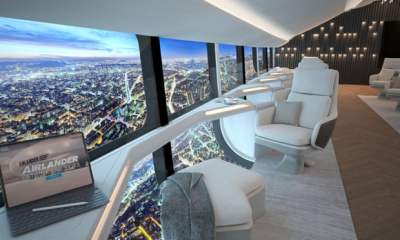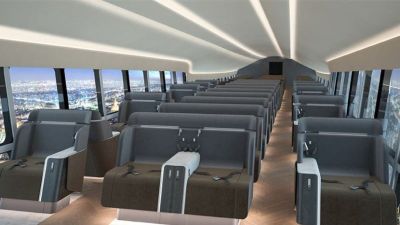Could Airships Make A Comeback With New Hybrid Designs?

Airships. Slow, difficult to land, and highly flammable when they’re full of hydrogen. These days, they’re considered more of a historical curiosity rather than a useful method of transport.
Hybrid Air Vehicles are a UK-based startup working to create a modern take on the airship concept. The goal is to create cleaner air transport for short-hop routes, while also solving many of the issues with the airship concept with a drastic redesign from the ground up. Their vehicle that will do all this goes by the name of Airlander 10. But is it enough to bring airships back to the skies?
A Hybrid Technology

The Airlander 10 is not a lighter-than-air craft like traditional airships. Instead, the vehicle uses the buoyancy from its helium envelope to create only 60-80% of its lift. The rest of the left is generated aerodynamically by air passing over the eliptical shape of the airship’s body. This lift can also be further augmented by two diesel-powered ducted fans on the sides of the airship, which can pivot to assist with takeoff and landing. Two further fixed ducted fans on the rear provide the primary propulsion for the craft.
The hybrid approach brings several benefits over the traditional airship model. Chief among them is that as the Airlander 10 is heavier than air, it need not vent helium throughout flight to avoid becoming positively buoyant as fuel burns off, nor does it need to vent helium to land. However, it still maintains the capability to loiter for incredibly long periods in the sky as it needs to burn very little fuel to stay aloft. Reportedly, it is capable of five days when manned, and even longer durations if operated in an unmanned configuration. Using helium for lift instead of solely relying on engine thrust and wings means that it is much more fuel efficient than traditional fixed-wing airliners. The company’s own estimates suggest the Airlander 10 could slash emissions on short-haul air routes by up to 90%. The gentle take-off and landing characteristics also mean the vehicle doesn’t require traditional airport facilities, making it possible to operate more easily in remote areas, on grass, sand, or even water.

There are drawbacks, of course, relative to more conventional air travel. The hybrid airship is only capable of a cruise speed of 148 km/h, far below the roughly 900 km/h of a modern jet airliner. The Airliner 10 is also large – at 91 meters long and 34 meters wide, it’s just as wide as a Boeing 737 and three times as long. Additionally, while it is capable of landing on unprepared flat surfaces, Hybrid Air Vehicles state that a 600m diameter circle is required. This is a significantly large area, and one that means finding a landing spot in many places could prove difficult.
Hybrid Air Vehicles have stated the Airlander 10 will be capable of carrying up to 100 passengers on short haul journeys, just over half of that carried by a modern single-row airliner. One proposed route for a passenger service is the short hop from Belfast to Liverpool. The former takes an hour on a conventional plane, or around 8 to 9 hours by ferry. The Airlander 10 would complete the journey in an estimated 5 hours and 20 minutes. Another proposed route, from Barcelona to Palma de Mallorca, goes much the same way, 1 hour by jet, or 9 hours by boat. The hybrid airship could split the difference at around 4 and a half hours.

Hybrid Air Vehicles claim that the added overheads of air travel, such as airport check-in and security clearances, add significantly to the flight time itself, thus giving the Airlander an advantage. However, it’s difficult to understand why their slower-moving air vehicle would be free of these requirements; even sea-going ferries take time to deal with docking and passenger loading.
It’s a slow, graceful thing in flight, as seen in this BBC clip from 2016. Noting the manner in which it takes to the air, the large required landing area could be due to the fact that taking off into the wind is critical for safety. There’s also an amusing story from 2017 in which the prototype craft came loose from its moorings on the morning after a test flight. The emergency deflation system activated when this occurred, with the craft coming to rest at the airfield perimeter. Imagine coming to work one day and the giant airship you’ve been working on is sitting halfway across the airfield from where you left it, with its empty balloon sagging as its stuck on the fence.

The new technology will have to compete with existing cheap flights; fares on airliners can often be had for under £50 on shorthop routes. The lower fuel use of the hybrid airship does help, of course. The Airlander 10 itself cost £25 million pounds to build, in amongst a £140 million development budget for Hybrid Air Vehicles. This pales in comparison to the $300 million or more required to purchase a modern single-aisle airliner. Operating and maintenance costs for four diesel piston engines are likely lower than those for two large jet engines as well. However, existing jet operations have the benefit of being well established and are familiar to the public.

The hybrid airship’s reliance on helium also tends to raise questions given the scarcity and expense of the element. The Hybrid Air Vehicles website claims that “600 Airlander aircraft would account for just 1% of annual helium consumption.” However, we suspect that calculation may have dropped a zero. 600 Airlander 10 aircraft, each using 38,000 cubic meters of helium, adds up to 22,800,000 million cubic meters of the gas. Roughly 160,000,000 cubic meters of the gas was produced in 2018; back of the envelope calculations would put the real figure somewhere between 10-15% of global supply in 2021. Of course, there aren’t that many Airlander 10 aircraft, with the company planning on building a more modest number of 12 airships a year from 2025. With helium shortages easing, there shouldn’t be any major issues with supply, though someone ought to sort out the maths on the website.
It’s rare for a new mode of transport to have an easy birth; the Channel Tunnel faced turmoil for years once it entered service. Passenger hovercraft once seemed like a silver bullet, too, but have all but faded away in recent decades. Whether or not the hybrid airship concept will become a regular transit link will depend on whether investors pony up the cash to get the concept over the line in the first place. From there, it’s up to operators to find a way to run the craft economically in the face of stiff competition from existing rivals.
Post a Comment